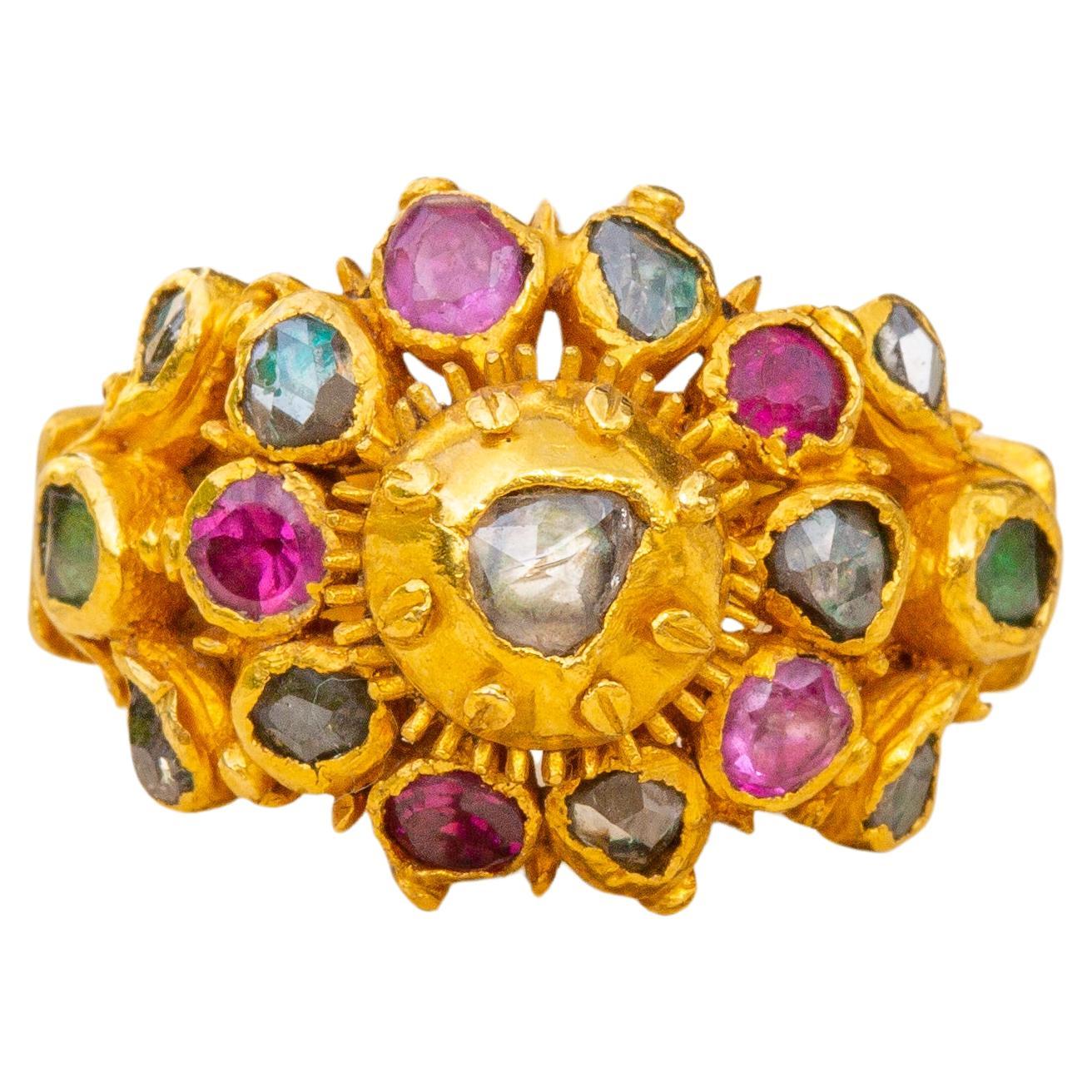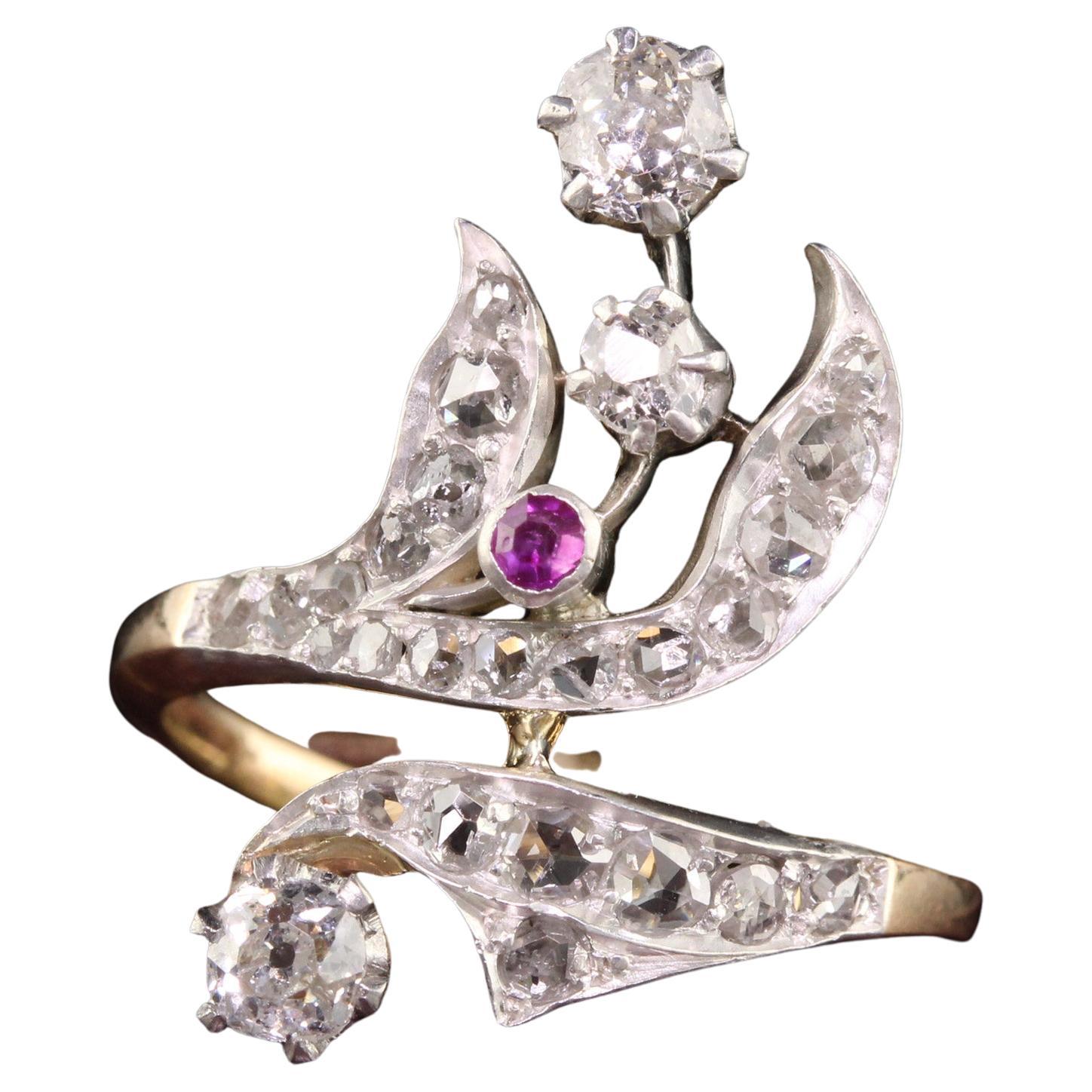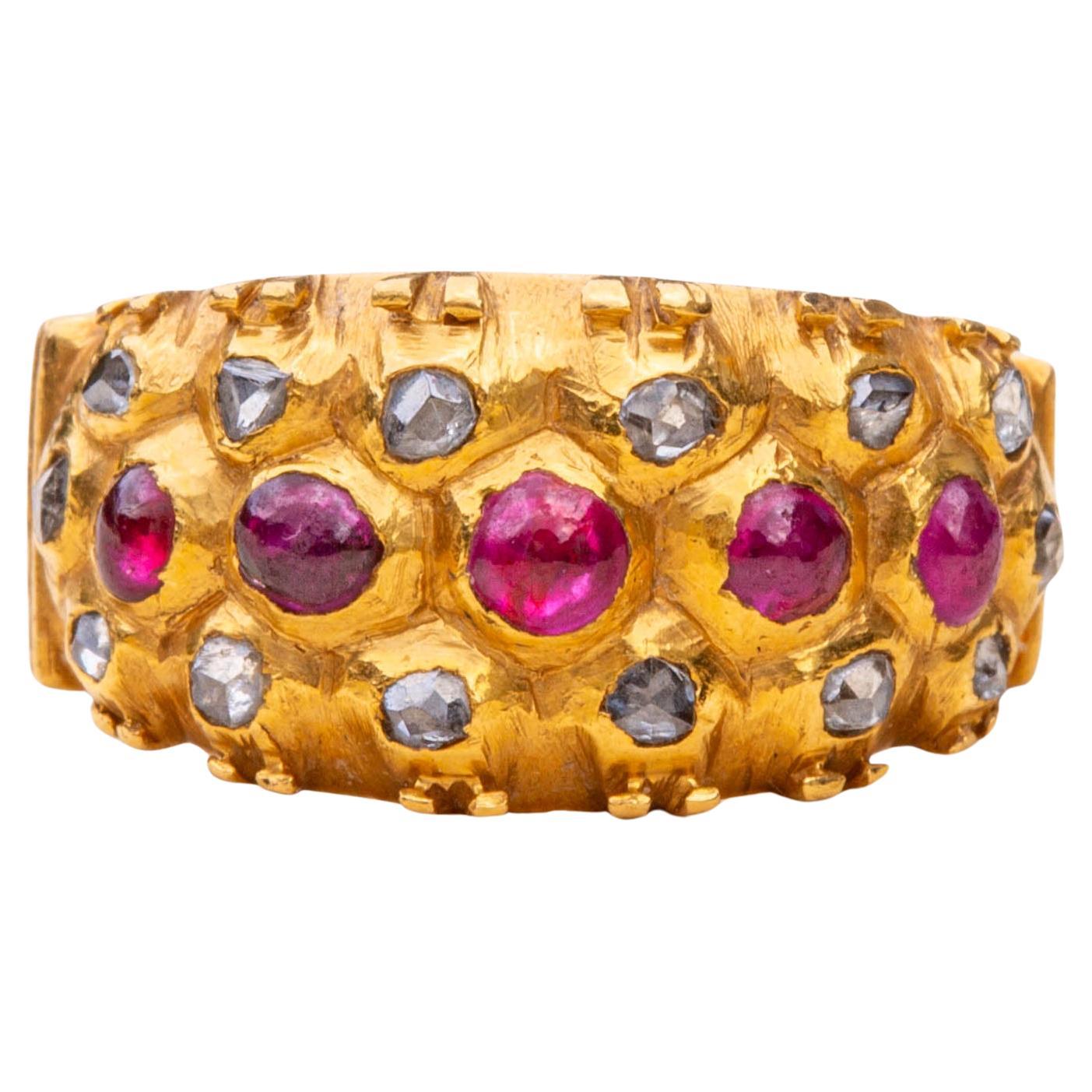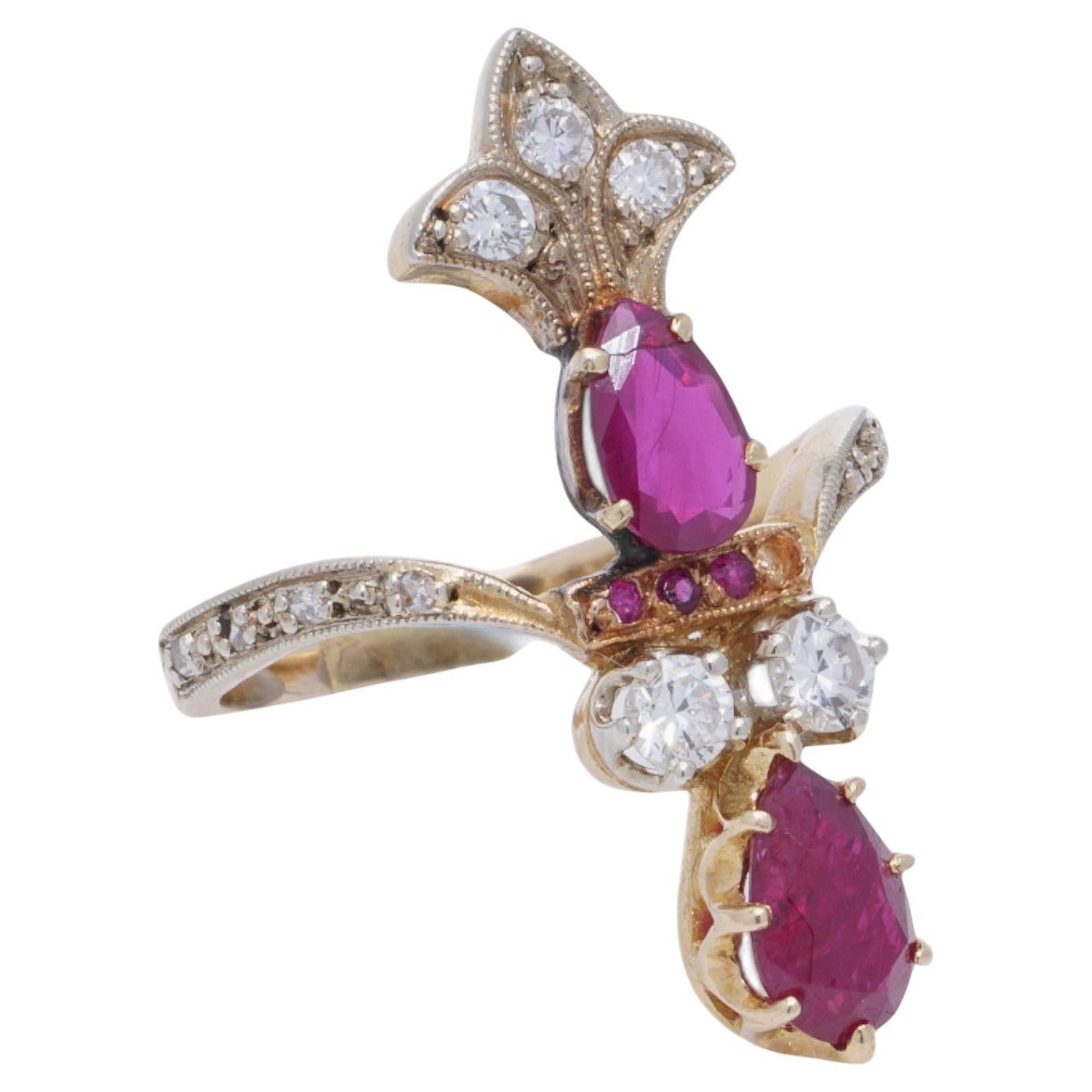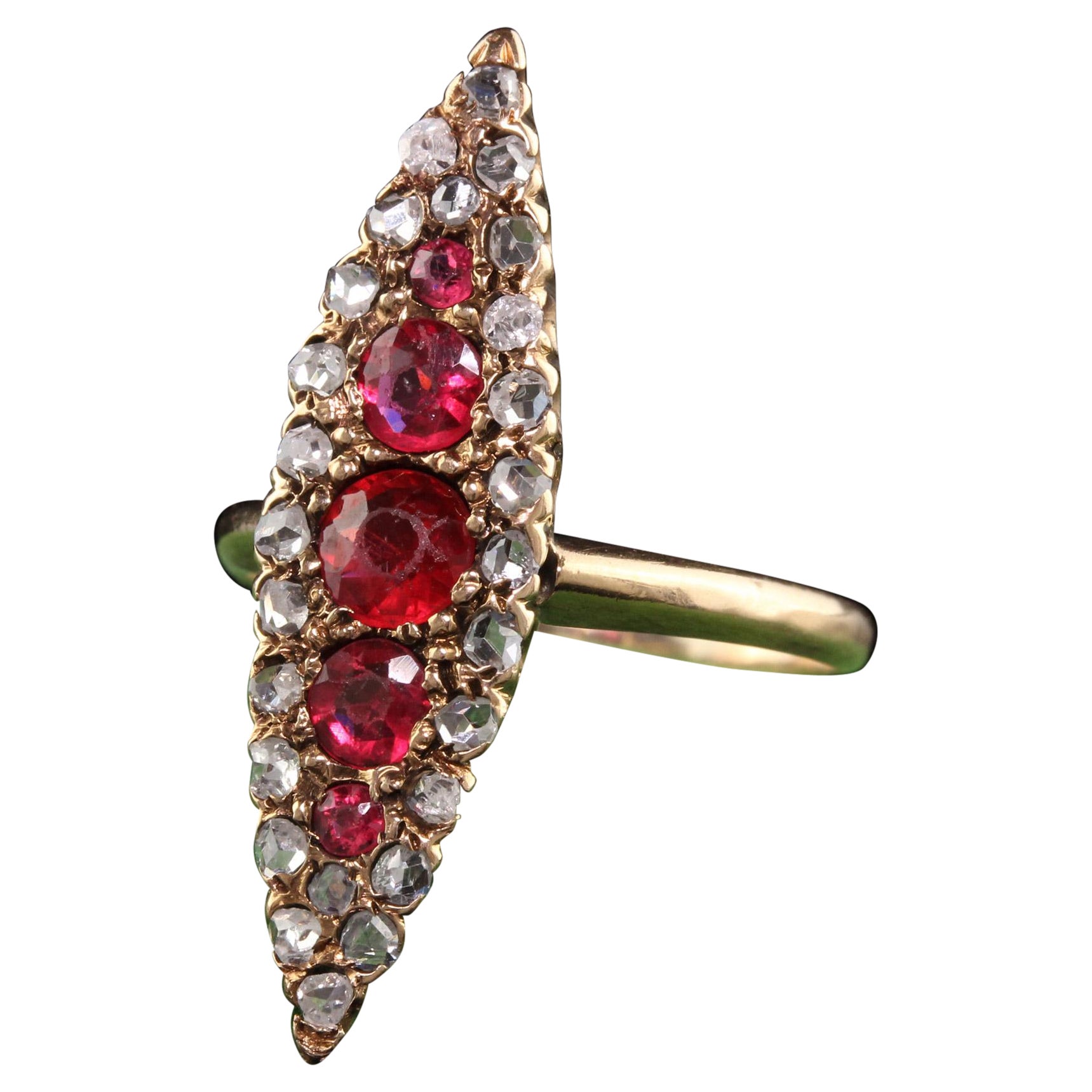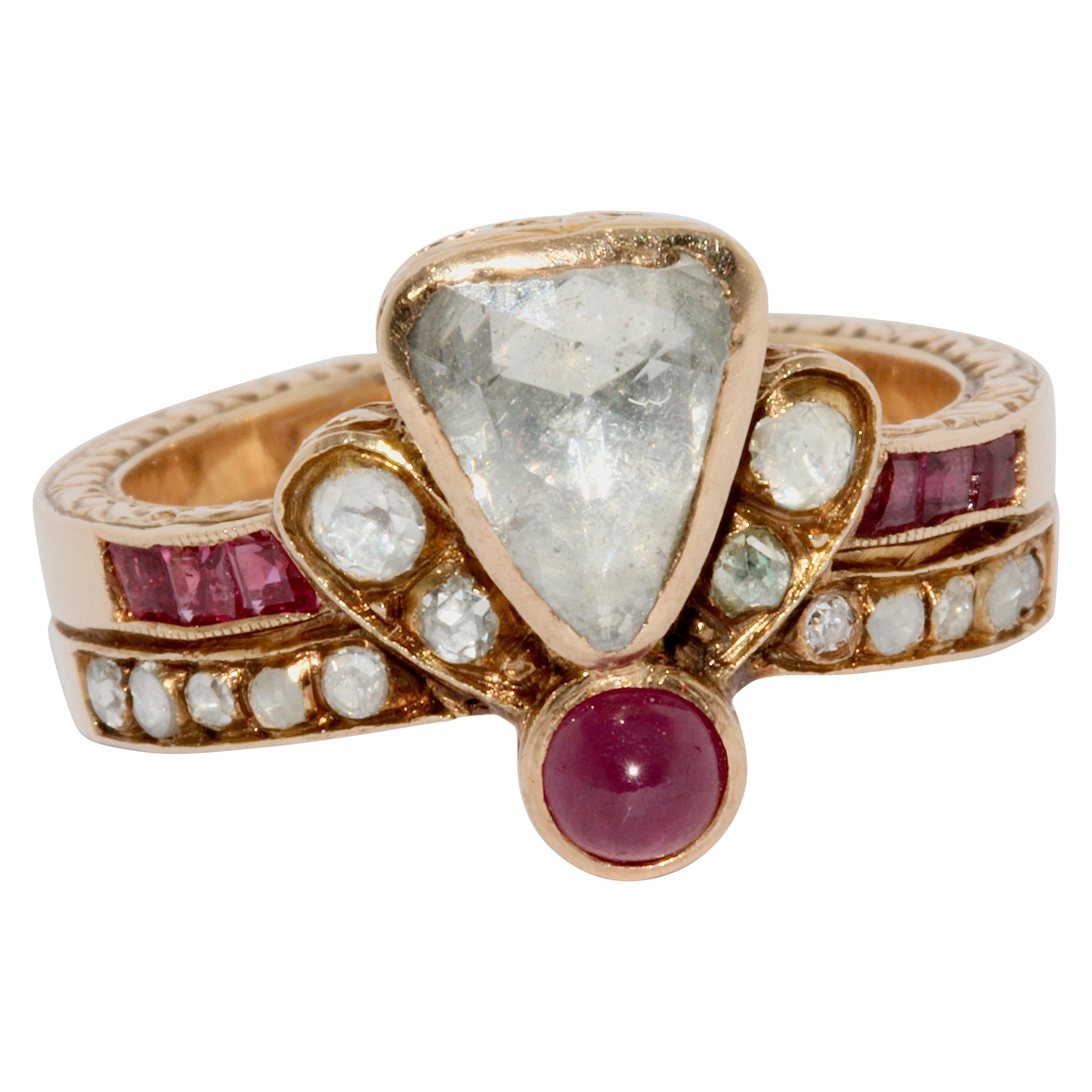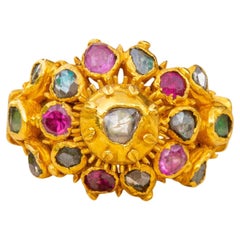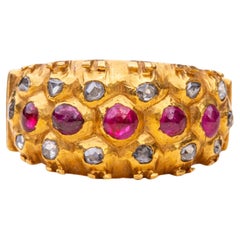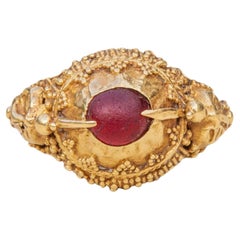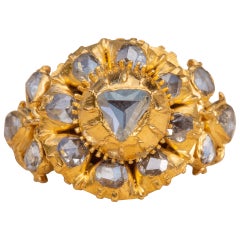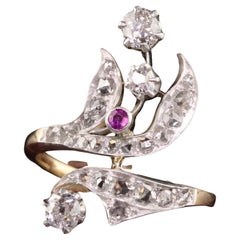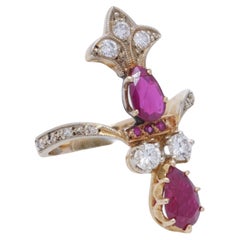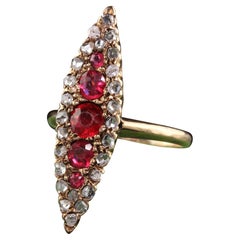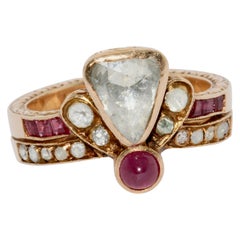Items Similar to Antique Thai Siam 19th Century Gold Rose Cut Diamond and Ruby Garuda Bird Ring
Want more images or videos?
Request additional images or videos from the seller
1 of 16
Antique Thai Siam 19th Century Gold Rose Cut Diamond and Ruby Garuda Bird Ring
$7,541.35
£5,500
€6,414.53
CA$10,326.68
A$11,481.87
CHF 5,995.20
MX$139,762.26
NOK 76,496.10
SEK 71,673.19
DKK 47,872.84
Shipping
Retrieving quote...The 1stDibs Promise:
Authenticity Guarantee,
Money-Back Guarantee,
24-Hour Cancellation
About the Item
A rare late 19th century gem-set princely gold ring made in Siam (Thailand). The ring takes the form of a mythical winged bird, possibly the Garuda bird.
Prevalent throughout Buddhism and Southeast Asian art, the Garuda or ‘Phra Khrut Pha’ ( พระครุฑพ่าห์ ) is a divine eagle-like sun bird and the king of birds. The mythical creature has been used as a symbol of royalty in Siam for centuries, and in 1911 it was adopted by Vajiravudh (Rama VI) as the national emblem of Thailand.
This is an extremely fine example of the lavish adornment paraphernalia commissioned and subsequently bestowed by the Kings of Siam in the 19th century, principally to be worn by participants in royal and aristocratic life-cycle ceremonies in the courts of Bangkok.
These princely rings would be made by the royal goldsmiths of the court of Bangkok. Aside from ceremonial use, rings like this one were also occasionally given as gifts to important visitors or other aristocratic families.
Examples of these lavish jewels being worn can be seen on old photos and paintings of life-cycle ceremonies such as the Royal Tonsure Ceremony, also known as ‘the cutting of the top-knot’ ceremony, which marked the transition into adulthood for all of the (many!) sons and daughters of the Siam royal family.
The huge expansion in the number of royals in 19th century Siam stemmed from Kings Mongkut (Rama IV) and Chulalongkorn (Rama V) being highly polygamous. They had a joint total of 124 wives and 159 royal children, each requiring their own ceremonial regalia and princely jewels. As a result, Bangkok became home to some incredibly skilled goldsmiths in this period.
This heavy 22K gold ring is a testament to the craftsmanship of the courtly Siam goldsmiths. The bezel head is composed of two layers, the uppermost, containing the large slightly larger rose cut black diamond, is riveted to the main body of the ring and allows for small rotation. The second layer features a spray of rose cut black diamonds in bezel settings with beaded and granulated rims, a feature of Siam jewellery of the period. There is also a star ruby cabochon, probably depicting the red face of the mythical bird. The band features an intricately engraved scrollwork pattern with pierced openwork sections.
Size: UK size J, US size 4.75
The face (bird) of the ring measures 27mm x 20mm and the central rose cut and ruby cabochon both have a diameter of 3.5mm. The ring weighs a total of 10.65 grams.
Upon magnification, the outer band carries a French gold import control mark, a requirement from when it would have been brought into the country at a later date. Following the relocation of the Thai monarchy to Switzerland in the 1930’s and 1940’s, other family members followed and settled in Europe (particularly France). Subsequently princely Thai items like this one occasionally appear on the open art market in Europe.
About the Seller
5.0
Vetted Professional Seller
Every seller passes strict standards for authenticity and reliability
Established in 2019
1stDibs seller since 2022
46 sales on 1stDibs
- ShippingRetrieving quote...Shipping from: London, United Kingdom
- Return Policy
Authenticity Guarantee
In the unlikely event there’s an issue with an item’s authenticity, contact us within 1 year for a full refund. DetailsMoney-Back Guarantee
If your item is not as described, is damaged in transit, or does not arrive, contact us within 7 days for a full refund. Details24-Hour Cancellation
You have a 24-hour grace period in which to reconsider your purchase, with no questions asked.Vetted Professional Sellers
Our world-class sellers must adhere to strict standards for service and quality, maintaining the integrity of our listings.Price-Match Guarantee
If you find that a seller listed the same item for a lower price elsewhere, we’ll match it.Trusted Global Delivery
Our best-in-class carrier network provides specialized shipping options worldwide, including custom delivery.More From This Seller
View AllAntique Thai Siam 19th Century Gold Princely Gem-Set Cluster Ring Ruby Emerald
Located in London, GB
A rare late 19th century gem-set princely gold cluster ring made in Siam (Thailand).
This gorgeous and colourful gem-set cluster ring is intricately crafted in high-karat gold, by the goldsmiths of the Siam court in the 19th century. The centre features a rose cut diamond in a rubber gold setting which is riveted to the body of the ring which is visible from the underside, a feature typical of 18th and 19th century Siam rings . It is surrounded by a halo of rubies, garnets and diamonds, with emeralds on the shoulders. The thick gold band features pierced scrollwork motifs and is stamped with a French gold import mark from when it was later brought into the country.
This ring is a fine example of the lavish adornment worn by participants in royal and aristocratic life-cycle ceremonies in the courts of Bangkok. Aside from ceremonial use, they were also occasionally given as gifts to important visitors or other aristocratic families. Examples of these lavish jewels being worn can be seen on old photos and paintings of life-cycle ceremonies such as the Royal Tonsure Ceremony, also known as ‘the cutting of the top-knot’ ceremony, which marked the transition into adulthood for all of the (many!) sons and daughters of the Siam royal family. The huge expansion in the number of royals in 19th century Siam stemmed from Kings Mongkut (Rama IV) and Chulalongkorn (Rama V...
Category
Antique 19th Century Thai Cluster Rings
Materials
Diamond, Ruby, Emerald, Gold
Royal 19th Century Siam Diamond and Ruby Ring
Located in London, GB
A rare 19th century princely gold cluster ring made in Siam (Thailand), circa 1860.This gorgeous ruby and diamond ring was intricately crafted in high-karat gold, by the goldsmiths of the royal Siam court in the 19th century.
It is a fine example of the lavish adornment worn by participants in royal and aristocratic life-cycle ceremonies in the courts of Bangkok. Aside from ceremonial use, they were also occasionally given as gifts to important visitors or other aristocratic families.
There was a huge expansion in the number of royals in 19th century Siam which stemmed from Kings Mongkut (Rama IV) and Chulalongkorn (Rama V) being highly polygamous. They had a joint total of 124 wives and 159 royal children, each requiring their own ceremonial regalia and princely jewels. As a result, Bangkok became home to some incredibly skilled goldsmiths in this period and the sheer number of jewellery required has meant that today princely jewels like this one can very occasionally be found in the open market, particularly in Europe following the relocation of the Thai royal family to Switzerland and France in the 1930’s and 1940’s.
The ring features a row of cabochon rubies horizontally aligned, surrounded by a sea of rose cut diamonds. All of the stones are in rubover settings within a web of hexagonal honeycomb frames. The band is decorated with pierced and deeply chased scrollwork motifs, typical of Siam jewellery...
Category
Antique Mid-19th Century Thai Band Rings
Materials
Diamond, Ruby, 22k Gold
Antique Gold Indonesian Bali Garnet Ring 19th Century Hummingbird Gold Ring
Located in London, GB
A scarce late 19th century gold ‘priest’s ring’ from the island of Bali, Indonesia.
The ring is a fantastic example of the southern Balinese style, where ...
Category
Antique Late 19th Century Engagement Rings
Materials
Gold
Important 19th Century Royal Siam Diamond Cluster Ring Museum-Grade Thai
Located in London, GB
An outstandingly rare mid-19th century royal Siam diamond cluster ring, made by the royal goldsmiths of the court of Bangkok.
This is an extremely fine example of the jewellery commissioned and subsequently bestowed by the Kings of Siam, principally to be worn by participants in royal and aristocratic life-cycle ceremonies in the courts of Bangkok. In the mid-19th century, King Mongkut (Rama IV) of Siam also commissioned the courtly jewellers to create a number of faithful replicas of these ceremonial jewels to be offered as gifts to diplomatic families, important visitors and to Heads of State across the world when re-establishing diplomatic relationships. One such example (which is remarkably similar to the present ring) resides in the museum of the Château de Fontainebleau (item F1518C) where it was given as a gift from King Mongkut to Napoléon-III on the important ambassadorial visit of 1861 (see photos for a side by side comparison).
Ceremonial Use:
During the 19th century, many rings were made every year by the royal jewellers for ceremonial use. Examples of these lavish cluster rings being worn for these life-cycle ceremonies can be seen on old photos and paintings of the Royal Tonsure Ceremony, also known as ‘the cutting of the top-knot’ ceremony, which marked the transition from childhood into adulthood for all of the (many!) sons and daughters of the Siam royal family.
The huge expansion in the number of royals in 19th century Siam stemmed from Kings Mongkut (Rama IV) and Chulalongkorn (Rama V) being highly polygamous. They had a joint total of 124 wives and 159 royal children, each requiring their own ceremonial regalia and princely jewels. As a result, Bangkok became home to some incredibly skilled goldsmiths in this period. The Tonsure ceremony was performed by the King, and lasted three days and three nights. All of the royal children would be dressed in the most splendid costumes and adorned with a vast amount of jewels on several parts of the body. Their costumes and jewels differed according to their title and rank. Diamonds for instance, would be bestowed to the highest ranking noble children. The royal children were allowed to keep their regalia and jewels as a present on entering adulthood to indicate their social status among society.
Over the years, these royal jewels have been dispersed across the many noble families, with currently only a few important pieces remaining in the royal collection. Today, the number of royals in Thailand is contracting as the country follows the Chinese nobility system whereby with each generation the noble rank of a family decreases by one ranking so that eventually the majority of descendants will lose their noble status completely. This loss of royal privilege, coupled with the dilution of wealth has meant that items such as this ring become available on the open market. Following the end of the absolute monarchy in Thailand in 1932, many members of the royal family relocated to Europe and as a consequence, princely Thai items can occasionally be found in the European art market.
Gift Exchange:
In Siam culture, great importance is placed on the ancestral process of gift-exchange. During the reign of King Mongkut, close relationships with some powerful countries were cultivated in order to hold the balance of power and to save Siam from being colonised. The King used gift-exchange to establish diplomatic relations with other heads of state around the world, as well as with other kings, princes and sultans closer to home. He sent troupes of ambassadors to England (1857) and France (1861) with seemingly endless amounts of trunks filled with lavish gifts in order to dazzle the heads of state with the extraordinary quality and variety of Siam craftsmanship.
These gifts consisted of faithful replicas of the Royal Regalia and objects belonging to the King himself; items and jewellery worn by him on his Tonsure ceremony and on his coronation day. Enormous time and effort was required by the Siam court to assemble these numerous gifts, as they emanated from the very same royal goldsmiths and courtly craftsman who had made the original ceremonial items.
The most famous of these ceremonies took place at the Chateau de Fontainebleau in 1861. The painting by Jean-Léon Gérôme that immortalised the event prominently features the most spectacular of these gifts. Among the 150 gifts presented to Napoléon-III by the Siam ambassadors were two diamond-set rings, both of which are on display in the Musée du Chateau de Fontainebleau (item no. F1518C and F1519C). One of these rings is a rose cut diamond cluster and bears a striking resemblance to the ring we are offering. According to Bruley (2011), this ring, presented to Napoleon-III, was a faithful replica of the ring worn by King Mongkut on his own coronation day in 1851, which now resides in the Pavilion of Royal Regalia in Thailand.
The Ring:
From whichever angle the present ring is viewed, it is a masterpiece of design and a testament to the ingenuity and craftsmanship of the Siam royal goldsmiths. The bezel head is composed of two layers, the uppermost, containing the large triangle shaped table-cut diamond, is riveted to the main body of the ring. The second layer of the cluster is set with a further eight rose cut diamonds and this section allows for small rotation, typical of Siam jewellery...
Category
Antique Mid-19th Century Thai Victorian Cluster Rings
Materials
Diamond, 22k Gold
Antique Georgian Early 19th Century 1ct Ruby and Diamond Target Cluster Ring
Located in London, GB
A superb antique Georgian ruby and diamond ring made in England, circa 1820. The centre of this ‘target’ shaped cluster ring is set with a 1ct cushion cut deep red ‘pigeon’s blood’ r...
Category
Antique Early 19th Century English Georgian Cluster Rings
Materials
Diamond, Ruby, 22k Gold
Royal Siam 'Thai' Museum-Grade 18th Century Ayutthaya Ceremonial Ring
Located in London, GB
This incredibly ornate piece was made in Siam during the late Ayutthaya or early Rattanakosin Kingdom period. It dates to the late 18th and is a very rare example of a ceremonial ‘mondop’ or ‘pagoda’ ring.
These rings were made for the monarchy and aristocratic class of Siam to be worn as part of the lavish adornment paraphernalia used in ceremonies. These elaborate rings were subsequently given as gifts to important visitors or other aristocratic families.
A similar example is found in Musée National du Château de Fontainebleau and was originally presented to Napoléon-III by the ambassadors of King Mongkut of Siam (Rama IV) alongside hundreds of other lavish gifts in order to re-establish diplomatic relations between France and Siam in 1861. Among these gifts are old jewels from King Mongkut’s treasury, including the gold diamond mondop/pagoda ring (see photos).
During this visit, the son of the Siamese ambassador, Khoumsombat, is photographed wearing a very similar tiered mondop ring with what also appears to be a ruby cabochon at the top (see photos).
A ‘mondop’ is the tiered roof of a temple, for example that of Wat Phra Kaew in Bangkok, and is designed to be in the shape of the image of Buddha. The top tier of this ring features a bezel set star ruby cabochon while the rest of the bezel is covered with diamonds. The two outermost tiers rotate and are connected to the main body of the ring with a bifurcated rivet visible on the closed-back underside of the bezel, typical ornamentation of 18th century layered cluster rings. The arched shoulders are equally as ornate with bezel set rub over diamonds, emeralds and rubies appearing between foliate motifs and protruding serpent-esque decoration. The underside and outershank display bright red and green floral enamelling often seen on naga rings...
Category
Antique Late 18th Century Thai More Rings
Materials
Diamond, Emerald, Ruby, 22k Gold
You May Also Like
Antique Victorian 18K Yellow Gold Silver Top Rose Cut and Ruby Floral Ring
Located in Great Neck, NY
Beautiful Antique Victorian 18K Yellow Gold Silver Top Rose Cut and Ruby Floral Ring. This gorgeous ring is crafted in 18k yellow gold and silver top....
Category
Antique 1890s Unknown Victorian Cocktail Rings
Materials
White Diamond, Ruby, Yellow Gold, Silver
Antique 18kt Gold Ladies Ring with Natural Burma Rubies and Diamonds
Located in Braintree, GB
Antique 18kt Gold Ladies Ring with Natural Burma Rubies and Diamonds
This antique ring was crafted in 18kt gold during the 1930s-1940s. Its design showcases the artistry of the era,...
Category
Vintage 1930s Cluster Rings
Materials
Diamond, Ruby, Gold, 18k Gold
Antique Victorian 14K Yellow Gold Ruby and Rose Cut Diamond Navette Ring
Located in Great Neck, NY
Beautiful Antique Victorian 14K Yellow Gold Ruby and Rose Cut Diamond Navette Ring. This gorgeous navette shield ring has a row of synthetic rubies in the center surrounded by rose c...
Category
Antique 1890s Unknown Victorian Cocktail Rings
Materials
Diamond, Ruby, Yellow Gold
Antique, Royal Gold Ring with Rose Cut Trillion Diamond, Rubies and Ornaments
Located in Berlin, DE
Magnificent, antique, royal gold ring with rose cut diamond, rubies and ornaments.
Ring set with a large rose-cut diamond of approximately 2 carat, additional diamonds and rubies.
...
Category
Antique 19th Century Victorian Band Rings
Materials
Diamond, White Diamond, Ruby
$12,471 Sale Price
20% Off
Free Shipping
Vintage Circa 1980s 14k Gold Natural Diamond And Ruby Decorated Cluster Ring
Located in Fatih/İstanbul, 34
In very good condition.
Total weight is 2.6 grams.
Totally is diamond 0.40 ct.
The diamond is has H color and vs-s1 clarity.
Totally is ruby 0.10 ct.
Ring size is US 3.75
We can mak...
Category
Vintage 1980s European Retro Cluster Rings
Materials
Diamond, Ruby, 14k Gold
$840 Sale Price
20% Off
Free Shipping
Vintage Indian Kundan 18K Gold Ring with 1ct Ruby and 1.8ct Rose-Cut Diamonds
Located in Miami, FL
A regal and richly detailed vintage Indian ring, handcrafted in 18 karat yellow gold in the traditional Kundan style. The bold, domed silhouette is adorned with intricate hand-engrav...
Category
Mid-20th Century Indian Revival Band Rings
Materials
Diamond, Ruby, 18k Gold, Yellow Gold
More Ways To Browse
Gold Thai
Antique Siam
Antique Royal Rings
1860 Gold Ring
Gold Rings With Birds
Antique Transitional Cut Diamond
Star Ruby Cabochon
Diamond Bird Ring
22k Rose Gold
1930 Rings Rose Gold
Spray Ring
Kings Court
Antique Cabochon Ruby Ring
1940s Diamond Ring Ruby
22k Gold Ruby Ring
Wing Rings
Antique Thai Ruby Ring
Diamond Spray Ring
